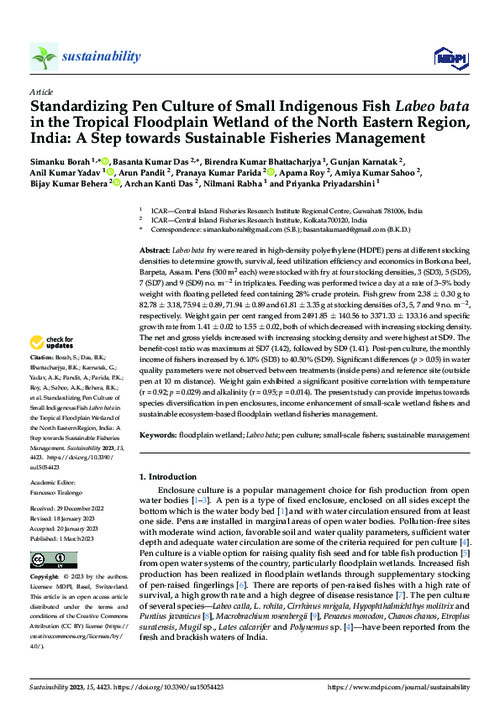Please use this identifier to cite or link to this item:
https://hdl.handle.net/20.500.12348/5954
Standardizing Pen Culture of Small Indigenous Fish Labeo bata in the Tropical Floodplain Wetland of the North Eastern Region, India: A Step towards Sustainable Fisheries Management
| dc.creator | Borah, S. | en_US |
| dc.creator | Das, B.K. | en_US |
| dc.creator | Bhattacharjya, B.K. | en_US |
| dc.creator | Karnatak, G. | en_US |
| dc.creator | Yadav, A.K. | en_US |
| dc.creator | Pandit, A. | en_US |
| dc.creator | Parida, P.K. | en_US |
| dc.creator | Roy, A. | en_US |
| dc.creator | Sahoo, A. | en_US |
| dc.creator | Behera, B.K. | en_US |
| dc.creator | Das, A.K. | en_US |
| dc.creator | Rabha, N. | en_US |
| dc.creator | Priyadarshini, P. | en_US |
| dc.date.accessioned | 2024-04-25T06:50:23Z | |
| dc.date.available | 2024-04-25T06:50:23Z | |
| dc.date.issued | 2023 | en_US |
| dc.identifier.citation | Simanku Borah, Basanta Das, Birendra Bhattacharjya, Gunjan Karnatak, Anil Yadav, Arun Pandit, Pranaya Parida, Aparna Roy, Amiya Kumar Sahoo, Bijay Behera, Archan Das, Nilmani Rabha, Priyanka Priyadarshini. (1/3/2023). Standardizing Pen Culture of Small Indigenous Fish Labeo bata in the Tropical Floodplain Wetland of the North Eastern Region, India: A Step towards Sustainable Fisheries Management. Sustainability, 15. | en_US |
| dc.identifier.issn | 2071-1050 | en_US |
| dc.identifier.uri | https://hdl.handle.net/20.500.12348/5954 | |
| dc.description.abstract | Lebeo bata fry were reared in high-density polyethylene (HDPE) pens at different stocking densities to determine growth, survival, feed utilization efficiency and economics in Borkona beel, Barpeta, Assam. Pens (500 m2 each) were stocked with fry at four stocking densities, 3 (SD3), 5 (SD5), 7 (SD7) and 9 (SD9) no. m−2 in triplicates. Feeding was performed twice a day at a rate of 3–5% body weight with floating pelleted feed containing 28% crude protein. Fish grew from 2.38 ± 0.30 g to 82.78 ± 3.18, 75.94 ± 0.89, 71.94 ± 0.89 and 61.81 ± 3.35 g at stocking densities of 3, 5, 7 and 9 no. m−2, respectively. Weight gain per cent ranged from 2491.85 ± 140.56 to 3371.33 ± 133.16 and specific growth rate from 1.41 ± 0.02 to 1.55 ± 0.02, both of which decreased with increasing stocking density. The net and gross yields increased with increasing stocking density and were highest at SD9. The benefit-cost ratio was maximum at SD7 (1.42), followed by SD9 (1.41). Post-pen culture, the monthly income of fishers increased by 6.10% (SD3) to 40.50% (SD9). Significant differences (p > 0.05) in water quality parameters were not observed between treatments (inside pens) and reference site (outside pen at 10 m distance). Weight gain exhibited a significant positive correlation with temperature (r = 0.92; p = 0.029) and alkalinity (r = 0.95; p = 0.014). The present study can provide impetus towards species diversification in pen enclosures, income enhancement of small-scale wetland fishers and sustainable ecosystem-based floodplain wetland fisheries management. | en_US |
| dc.format | en_US | |
| dc.language | en | en_US |
| dc.publisher | MDPI | en_US |
| dc.rights | CC-BY-4.0 | en_US |
| dc.source | Sustainability;15,(2023) | en_US |
| dc.subject | sustainable management | en_US |
| dc.subject | small-scale fishers | en_US |
| dc.subject | floodplain wetland | en_US |
| dc.title | Standardizing Pen Culture of Small Indigenous Fish Labeo bata in the Tropical Floodplain Wetland of the North Eastern Region, India: A Step towards Sustainable Fisheries Management | en_US |
| dc.type | Journal Article | en_US |
| cg.contributor.funder | WorldFish | en_US |
| cg.contributor.project | ICAR Collaborative Work Program | en_US |
| cg.coverage.country | India | en_US |
| cg.coverage.region | Southern Asia | en_US |
| cg.subject.agrovoc | labeo bata | en_US |
| cg.subject.agrovoc | pen culture | en_US |
| cg.subject.agrovoc | fish | en_US |
| cg.contributor.affiliation | WorldFish | en_US |
| cg.contributor.affiliation | Indian Council of Agricultural Research, Central Inland Fisheries Research Institute | en_US |
| cg.identifier.status | Open access | en_US |
| cg.identifier.ISIindexed | ISI indexed | en_US |
| cg.description.theme | Sustainable aquaculture | en_US |
| dc.identifier.doi | https://dx.doi.org/10.3390/su15054423 | en_US |
| cg.subject.sdg | SDG 14 - Life below water | en_US |
| cg.subject.impactArea | Poverty reduction, livelihoods and jobs | en_US |
| cg.subject.impactArea | Environmental health and biodiversity | en_US |
Files in this item
This item appears in the following Collection(s)
-
Sustainable aquaculture [2735]
